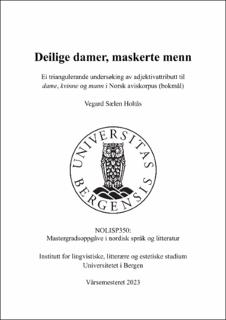| dc.contributor.author | Holtås, Vegard Sælen | |
| dc.date.accessioned | 2023-06-13T23:56:29Z | |
| dc.date.available | 2023-06-13T23:56:29Z | |
| dc.date.issued | 2023-05-15 | |
| dc.date.submitted | 2023-06-13T22:00:13Z | |
| dc.identifier.uri | https://hdl.handle.net/11250/3071222 | |
| dc.description.abstract | Avhandlinga er ei korpusbasert undersøking basert på problemstillinga: I kva grad og korleis vert grad kvinner og menn tillagde ulike eigenskapar gjennom adjektivbruken i norske aviser? Dette vert utforska ved å undersøkja den relative fordelinga av ulike adjektivattributt i nomenfrasar med dei tre kjønnsmarkerte substantiva dame, kvinne og mann. Materialet er henta frå Norsk aviskorpus (bokmål), eit stort monitorkorpus med tekster henta frå norske nettaviser fra perioden 1994 og 2022. Undersøkinga er triangulerande og kombinerer kvantitative og kvalitative metodar. Oppgåva er bygd opp av tre delundersøkingar. Første delundersøking nyttar metoden distinktiv kolleksemanalyse, andre delundersøking nyttar komparativ analyse av semantiske kolleksemkategoriar, og tredje delundersøking nyttar kritisk diskursanalyse av konkordansar. Oppgåva har fem hovudkapittel. I kapittel 2 er det gjort greie for dei teoretiske perspektiva som ligg til grunn; dette inkluderer tidlegare forsking på feltet språk og kjønn, marxistiske perspektiv på språk og ideologi, medievitskaplege perspektiv på aviser og avisspråk, og grammatisk teori om syntaktiske og semantiske egenskaper ved adjektiv i norsk. I kapittel 3 er metodane for undersøkinga skildra. Metodekapittelet byggjer i stor utstrekning på Stefanowitsch (2020) og Baker (2006). Kapittel 4 presenterer resultata av den distinktive kolleksemanalysen, kapittel 5 presenterer den komparative analysen av semantiske kategoriar. Kapittel 6 er ein kritisk analyse av konkordansar. I kapittel 7 er resultata diskuterte i ljos av relevant teori. I første delundersøking var det funne stor variasjon mellom dei distinktive adjektivkolleksema som var assosierte med substantiva dame, kvinne og mann. Andre delundersøking viste at adjektiva som var assosierte med dame og kvinne høyrde til ulike semantiske kategoriar; det same gjaldt for dame og kvinne sett under eitt og jamført med mann. Tredje delundersøking vise at adjektiva moden og stor vart nytta med noko ulike tydingar avhengig av om dei modifiserte kvinne eller mann. | |
| dc.description.abstract | The thesis is a corpus-based study based on the research question. To what degree and how are different qualities ascribed to women and men through the adjective usage in Norwegian newspapers? This was explored by investigating the relative distribution of different adjective modifiers in noun phrases with the three gender-marked nouns dame, kvinne and mann. The data was obtained from the Norwegian Newspaper Corpus (bokmål), a large monitor corpus containing texts from Norwegian online newpapers in the period 1994-2022. The study takes a triangulating approach and combines quantitative and qualitative methods. The thesis consists of three partial studies. The first partial study uses the method of distinctive collexeme analysis, the second partial study uses a comparative analysis of semantic collexeme categories, and the third partial study is a critical discourse analysis of concordances. The thesis has five main chapters. In chapter 2, the main theoretical perspectives are presented; these include earlier research in the field of language and gender, Marxist perspectives on language and ideology, media research perspectives on newspapers and newspaper language, and grammatical theory on the syntactic and semantic qualities of adjectives in Norwegian. The research methods are described in chapter 3. The method chapter builds to a large extent on Stefanowitsch (2020) and Baker (2006). In chapter 4, the results of the disctinctive collexeme analysis are presented. Chapter 5 presents the comparative analysis of semantic categories is presented. Chapter 6 is a critical analysis of concordances. In chapter 7, findings are discussed in light of relevant theory. In the first partial study, large variations were found between the disctintive collexemes associated with dame, kvinne and mann. The second partial study showed that the adjective modifiers associated with dame and kvinne belonged to different semantic category; the same applied to dame and kvinne taken together and compared to mann. The third partial study showed how the adjectives moden and stor were used with different meanings depending on whether they were modifying kvinne or mann. | |
| dc.language.iso | nno | |
| dc.publisher | The University of Bergen | |
| dc.rights | Copyright the Author. All rights reserved | |
| dc.subject | kolleksem | |
| dc.subject | adjektiv | |
| dc.subject | menn | |
| dc.subject | språk og kjønn | |
| dc.subject | kvinner | |
| dc.subject | norsk aviskorpus | |
| dc.subject | bokmål | |
| dc.subject | leksikografi | |
| dc.subject | aviser | |
| dc.subject | avisspråk | |
| dc.title | Deilige damer, maskerte menn: Ei triangulerande undersøking av adjektivattributt til dame, kvinne og mann i Norsk aviskorpus (bokmål) | |
| dc.title.alternative | Title: Deilige damer, maskerte menn: A triangulating analysis of adjective modifiers to dame, kvinne and mann in the Norwegian Newspaper Corpus (bokmål). Vegard Sælen Holtås, 2023. | |
| dc.type | Master thesis | |
| dc.date.updated | 2023-06-13T22:00:13Z | |
| dc.rights.holder | Copyright the Author. All rights reserved | |
| dc.description.degree | Mastergradsoppgåve i nordisk språk og litteratur | |
| dc.description.localcode | NOLISP350 | |
| dc.description.localcode | MAHF-LÆNO | |
| dc.description.localcode | MAHF-NORD | |
| dc.subject.nus | 711123 | |
| fs.subjectcode | NOLISP350 | |
| fs.unitcode | 11-21-0 | |
